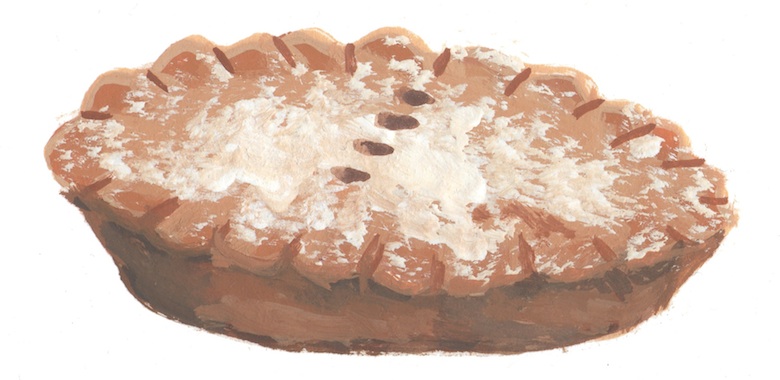
Editor’s note: As we roll out our holiday issue, we’re sharing personal holiday essays from some of our regular contributors. We asked an international cohort of New Yorkers to share a memory of a seasonal dish from their childhood. Read more from Ruth Temianka below and find a version of this mince pie at Myers of Keswick.
My holiday food memories transition rather abruptly from the bright and delicate delights of a French bûche de Noël to the warm, dense puddings and pastries of England. Family arguments over the holidays have a lot to answer for, in my case an overnight transition from living in the green pastures of Northern France to the cold confines of an old house in the English West Country.
Governed by a strict grandmother who believed children should be seen and not heard — and most certainly in bed by 6:00 p.m. — Christmas initially proved to be lacking in glad tidings. However one small area of my new home channeled warmth that cut through the cold lard and cruet pots: the kitchen. Here the tight-lipped hospital cleaner, who so proudly elevated herself from being an unschooled gardener’s daughter in the aftermath of World War I to the respectable owner of a “two-up, two-down” in the nearby town, applied years of elbow grease to a special cause. The shortcrust mince pie, all unkempt and wild with its burnt splatter of mincemeat that had erupted during baking, was the one testament to the inner fires of post-Victorian convection that stirred both inside the heart of her home and her own breast. My grandmother cleaned and baked to show love.
On baking day, the amber glow and spices from those pies combined with the stoutness of lard and life that filled our young bellies. Each crumbly case (lidless versions are known as “mince tarts”) contained the moist magic of mincemeat: apple, candied peel, vine fruits, warming spices and shredded suet: traditionally hard beef or mutton fat from around the loins and kidney area that adds an unctuous quality to mincemeat when heated. A tantalizing combination at the best of times.
To this day the smell of spice in Christmas mince pies brings me back to that kitchen. Here the bloom of Lilian Rosita remains attached to the image of a faded but fiery-eyed mother, ready to tackle homes and hospitals in her hair net and bicycle clips until a botched hip operation in her 90s stems mobility, ambition and the warm currents of hearth and heart.
Though since replaced by the thousand assembled on a cold cake factory assembly-line as a student, the sugary supermarket versions, or the fresh new ones discovered on a brave new continent at Myers of Keswick (who sources their meat and ingredients from the only local butcher left nearby in Manhattan’s former meat market), the humble mince pie remains inextricably linked to that lady, whose passing I still mourn as much as real mince. Though the chill of holidays and people can sometimes overshadow the best intentions, time proves respect and warmth can grow from cold just as the spring sets new life in the wintry ground. Mince pies set me back and forward in time. Not bad for a small pastry. Though I would advocate for a slightly less dramatic start to a worthy tradition, mince pies still stand for everything childhood reveals as good. For adults they’re just as delicious, even the crusty burned bits.



